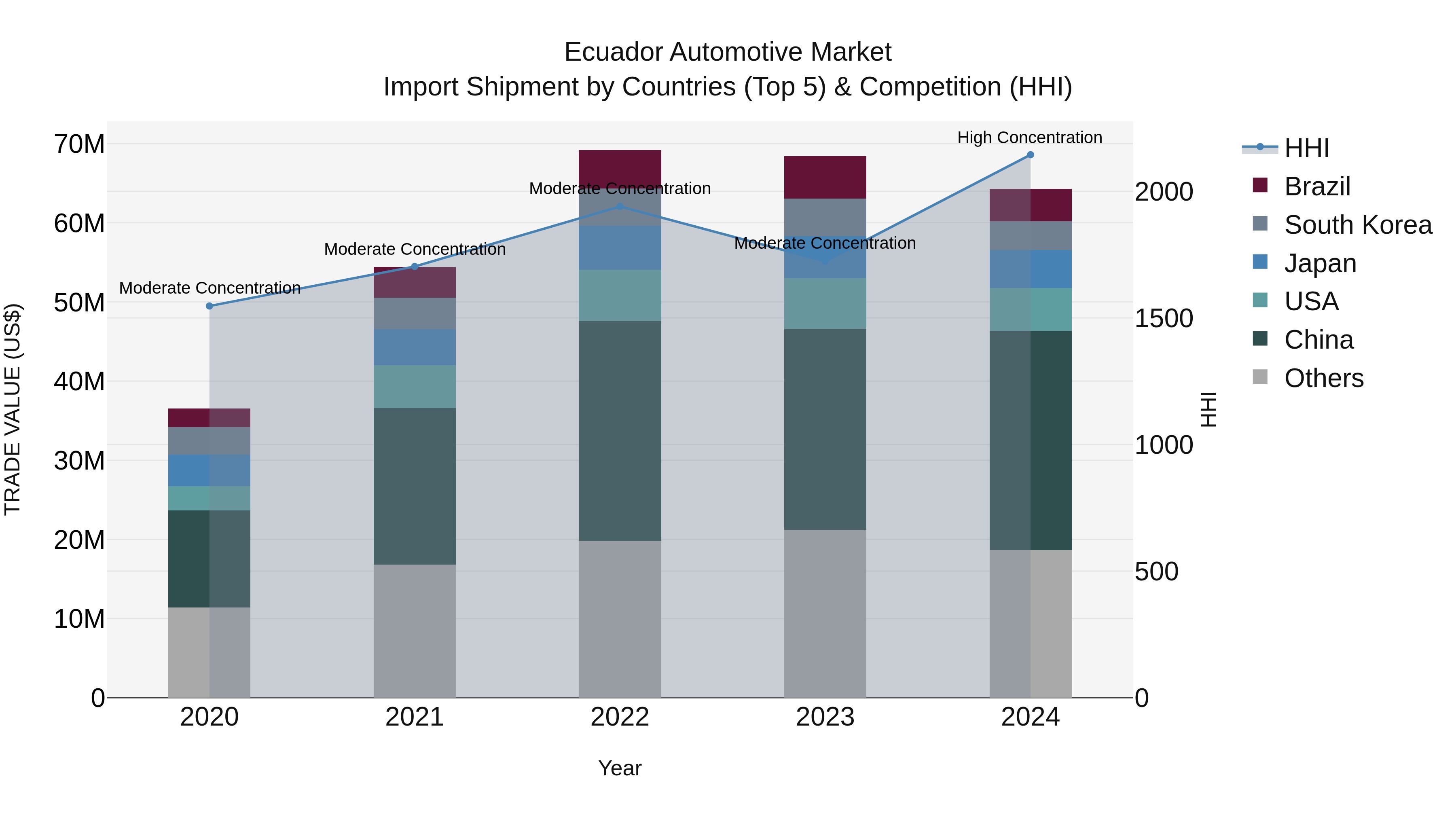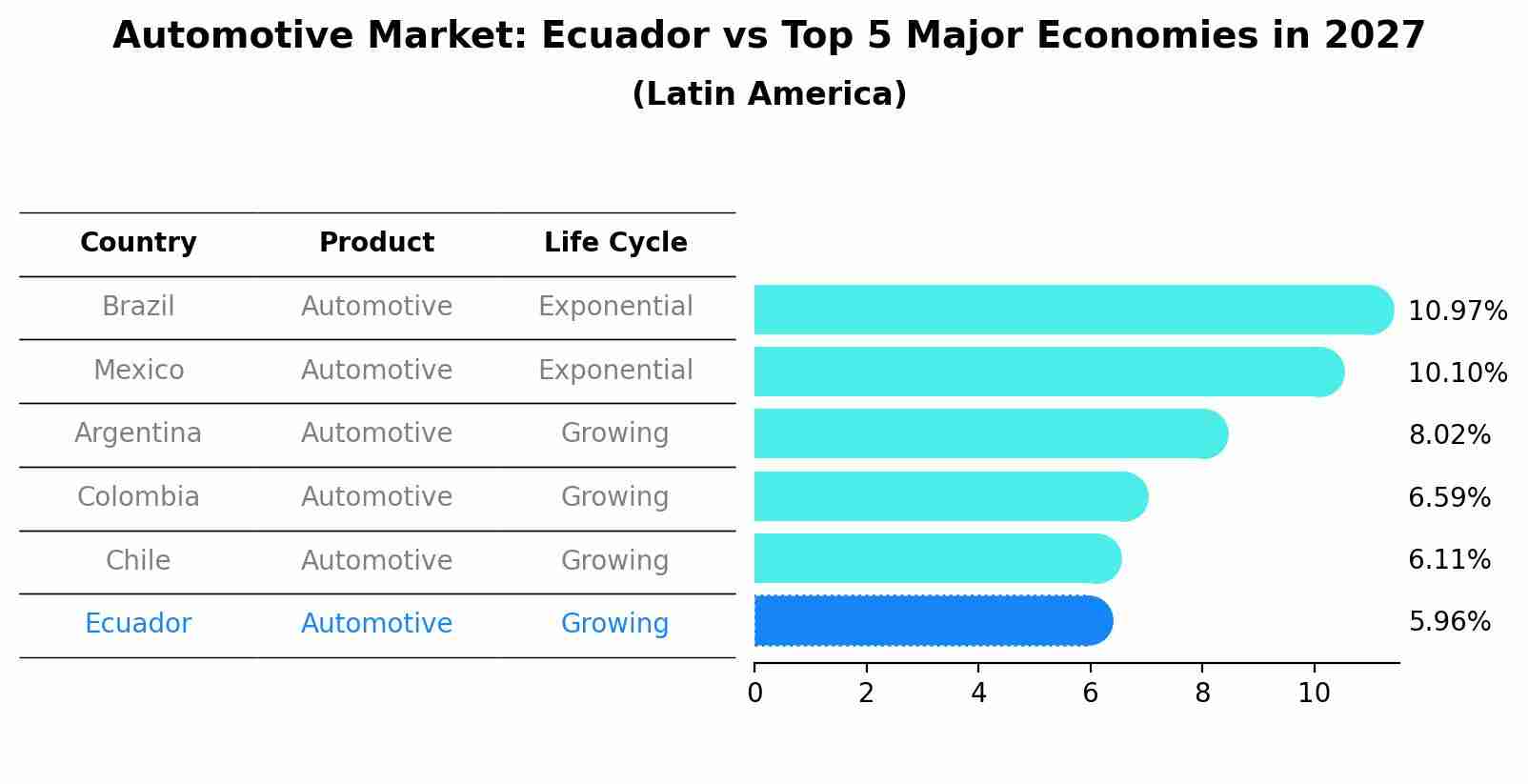Ecuador Automotive Market (2025-2031) | Outlook, Analysis, Revenue, Industry, Size, Growth, Value, Segmentation, Trends, Share, Forecast & Companies
| Product Code: ETC5405015 | Publication Date: Nov 2023 | Updated Date: Oct 2025 | Product Type: Market Research Report | |
| Publisher: 6Wresearch | Author: Ravi Bhandari | No. of Pages: 60 | No. of Figures: 30 | No. of Tables: 5 |
Ecuador Automotive Market Top 5 Importing Countries and Market Competition (HHI) Analysis
Ecuador`s automotive import Market Top 5 Importing Countries and Market Competition (HHI) Analysis saw a notable shift in 2024, with top exporters being China, USA, Japan, Brazil, and Taiwan. The Market Top 5 Importing Countries and Market Competition (HHI) Analysis experienced a significant increase in concentration levels, transitioning from moderate to high concentration. Despite a slight decline in growth rate from 2023 to 2024, the compound annual growth rate over the period 2020-24 remained strong at 15.15%. This data suggests a dynamic and evolving automotive import landscape in Ecuador, indicating potential opportunities and challenges for Market Top 5 Importing Countries and Market Competition (HHI) Analysis players in the coming years.

Automotive Market: Ecuador vs Top 5 Major Economies in 2027 (Latin America)
In the Latin America region, the Automotive market in Ecuador is projected to expand at a growing growth rate of 5.96% by 2027. The largest economy is Brazil, followed by Mexico, Argentina, Colombia and Chile.

Key Highlights of the Report:
- Ecuador Automotive Market Outlook
- Market Size of Ecuador Automotive Market, 2024
- Forecast of Ecuador Automotive Market, 2031
- Historical Data and Forecast of Ecuador Automotive Revenues & Volume for the Period 2021-2031
- Ecuador Automotive Market Trend Evolution
- Ecuador Automotive Market Drivers and Challenges
- Ecuador Automotive Price Trends
- Ecuador Automotive Porter`s Five Forces
- Ecuador Automotive Industry Life Cycle
- Historical Data and Forecast of Ecuador Automotive Market Revenues & Volume By Product Type for the Period 2021-2031
- Historical Data and Forecast of Ecuador Automotive Market Revenues & Volume By Electric for the Period 2021-2031
- Historical Data and Forecast of Ecuador Automotive Market Revenues & Volume By Hybrid Electric for the Period 2021-2031
- Historical Data and Forecast of Ecuador Automotive Market Revenues & Volume By Plug-In Hybrid Electric for the Period 2021-2031
- Historical Data and Forecast of Ecuador Automotive Market Revenues & Volume By Mild Hybrid for the Period 2021-2031
- Historical Data and Forecast of Ecuador Automotive Market Revenues & Volume By Natural Gas for the Period 2021-2031
- Historical Data and Forecast of Ecuador Automotive Market Revenues & Volume By Fuel Cell Electric for the Period 2021-2031
- Historical Data and Forecast of Ecuador Automotive Market Revenues & Volume By Diesel for the Period 2021-2031
- Historical Data and Forecast of Ecuador Electric Automotive Market Revenues & Volume By Petrol for the Period 2021-2031
- Ecuador Automotive Import Export Trade Statistics
- Market Opportunity Assessment By Product Type
- Ecuador Automotive Top Companies Market Share
- Ecuador Automotive Competitive Benchmarking By Technical and Operational Parameters
- Ecuador Automotive Company Profiles
- Ecuador Automotive Key Strategic Recommendations
Frequently Asked Questions About the Market Study (FAQs):
1 Executive Summary |
2 Introduction |
2.1 Key Highlights of the Report |
2.2 Report Description |
2.3 Market Scope & Segmentation |
2.4 Research Methodology |
2.5 Assumptions |
3 Ecuador Automotive Market Overview |
3.1 Ecuador Country Macro Economic Indicators |
3.2 Ecuador Automotive Market Revenues & Volume, 2021 & 2031F |
3.3 Ecuador Automotive Market - Industry Life Cycle |
3.4 Ecuador Automotive Market - Porter's Five Forces |
3.5 Ecuador Automotive Market Revenues & Volume Share, By Product Type, 2021 & 2031F |
4 Ecuador Automotive Market Dynamics |
4.1 Impact Analysis |
4.2 Market Drivers |
4.2.1 Growing disposable income levels in Ecuador leading to increased purchasing power for automobiles |
4.2.2 Improving infrastructure and road networks in the country driving demand for vehicles |
4.2.3 Government initiatives promoting automotive industry growth and attracting investments |
4.3 Market Restraints |
4.3.1 Economic instability and fluctuations in currency exchange rates impacting consumer confidence and purchasing behavior |
4.3.2 High import tariffs and taxes on automobiles affecting affordability and sales in the market |
5 Ecuador Automotive Market Trends |
6 Ecuador Automotive Market Segmentations |
6.1 Ecuador Automotive Market, By Product Type |
6.1.1 Overview and Analysis |
6.1.2 Ecuador Automotive Market Revenues & Volume, By Electric, 2021-2031F |
6.1.3 Ecuador Automotive Market Revenues & Volume, By Hybrid Electric, 2021-2031F |
6.1.4 Ecuador Automotive Market Revenues & Volume, By Plug-In Hybrid Electric, 2021-2031F |
6.1.5 Ecuador Automotive Market Revenues & Volume, By Mild Hybrid, 2021-2031F |
6.1.6 Ecuador Automotive Market Revenues & Volume, By Natural Gas, 2021-2031F |
6.1.7 Ecuador Automotive Market Revenues & Volume, By Fuel Cell Electric, 2021-2031F |
6.1.9 Ecuador Automotive Market Revenues & Volume, By Petrol, 2021-2031F |
6.1.10 Ecuador Automotive Market Revenues & Volume, By Petrol, 2021-2031F |
7 Ecuador Automotive Market Import-Export Trade Statistics |
7.1 Ecuador Automotive Market Export to Major Countries |
7.2 Ecuador Automotive Market Imports from Major Countries |
8 Ecuador Automotive Market Key Performance Indicators |
8.1 Average age of vehicles on the road in Ecuador |
8.2 Number of licensed drivers in the country |
8.3 Fuel efficiency standards and adoption of eco-friendly vehicles in the market |
9 Ecuador Automotive Market - Opportunity Assessment |
9.1 Ecuador Automotive Market Opportunity Assessment, By Product Type, 2021 & 2031F |
10 Ecuador Automotive Market - Competitive Landscape |
10.1 Ecuador Automotive Market Revenue Share, By Companies, 2024 |
10.2 Ecuador Automotive Market Competitive Benchmarking, By Operating and Technical Parameters |
11 Company Profiles |
12 Recommendations | 13 Disclaimer |
- Single User License$ 1,995
- Department License$ 2,400
- Site License$ 3,120
- Global License$ 3,795
Search
Thought Leadership and Analyst Meet
Our Clients
Related Reports
- Afghanistan Apparel Market (2026-2032) | Growth, Outlook, Industry, Segmentation, Forecast, Size, Companies, Trends, Value, Share, Analysis & Revenue
- Canada Oil and Gas Market (2026-2032) | Share, Segmentation, Value, Industry, Trends, Forecast, Analysis, Size & Revenue, Growth, Competitive Landscape, Outlook, Companies
- Germany Breakfast Food Market (2026-2032) | Industry, Share, Growth, Size, Companies, Value, Analysis, Revenue, Trends, Forecast & Outlook
- Australia Briquette Market (2025-2031) | Growth, Size, Revenue, Forecast, Analysis, Trends, Value, Share, Industry & Companies
- Vietnam System Integrator Market (2025-2031) | Size, Companies, Analysis, Industry, Value, Forecast, Growth, Trends, Revenue & Share
- ASEAN and Thailand Brain Health Supplements Market (2025-2031) | Strategy, Consumer Insights, Analysis, Investment Trends, Opportunities, Growth, Size, Share, Industry, Revenue, Segments, Value, Segmentation, Supply, Forecast, Restraints, Outlook, Competition, Drivers, Trends, Demand, Pricing Analysis, Competitive, Strategic Insights, Companies, Challenges
- ASEAN Bearings Market (2025-2031) | Strategy, Consumer Insights, Analysis, Investment Trends, Opportunities, Growth, Size, Share, Industry, Revenue, Segments, Value, Segmentation, Supply, Forecast, Restraints, Outlook, Competition, Drivers, Trends, Demand, Pricing Analysis, Competitive, Strategic Insights, Companies, Challenges
- Europe Flooring Market (2025-2031) | Outlook, Share, Industry, Trends, Forecast, Companies, Revenue, Size, Analysis, Growth & Value
- Saudi Arabia Manlift Market (2025-2031) | Outlook, Size, Growth, Trends, Companies, Industry, Revenue, Value, Share, Forecast & Analysis
- Uganda Excavator, Crane, and Wheel Loaders Market (2025-2031) | Strategy, Consumer Insights, Analysis, Investment Trends, Opportunities, Growth, Size, Share, Industry, Revenue, Segments, Value, Segmentation, Supply, Forecast, Restraints, Outlook, Competition, Drivers, Trends, Demand, Pricing Analysis, Competitive, Strategic Insights, Companies, Challenges
Industry Events and Analyst Meet
Whitepaper
- Middle East & Africa Commercial Security Market Click here to view more.
- Middle East & Africa Fire Safety Systems & Equipment Market Click here to view more.
- GCC Drone Market Click here to view more.
- Middle East Lighting Fixture Market Click here to view more.
- GCC Physical & Perimeter Security Market Click here to view more.
6WResearch In News
- Doha a strategic location for EV manufacturing hub: IPA Qatar
- Demand for luxury TVs surging in the GCC, says Samsung
- Empowering Growth: The Thriving Journey of Bangladesh’s Cable Industry
- Demand for luxury TVs surging in the GCC, says Samsung
- Video call with a traditional healer? Once unthinkable, it’s now common in South Africa
- Intelligent Buildings To Smooth GCC’s Path To Net Zero


















